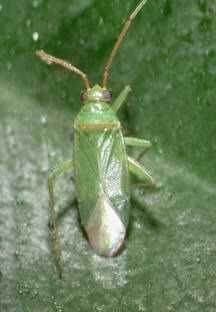Honeylocust Plant Bug
 DESCRIPTION & LIFE CYCLE
DESCRIPTION & LIFE CYCLE
Adults are approximately 3/16″ long and are pale green. Nymphs are smaller but similar to the adults in color and have a distinct orange spot in the middle of the abdomen. They feed on the tender new growth of honeylocust and so closely resemble it in color that they may be hard to detect.
Eggs, which overwinter in woody tissue, begin to hatch about late April in Pennsylvania or at the time of bud break on honeylocust. Nymphs go through five stages and begin to mature into adults in late May. They are most abundant during early June and begin to decline in numbers in late June, and disappear by early July. There is only one generation per season.
DAMAGE
Nymphs begin feeding just after bud break, or at the most susceptible period of the tree’s growth. Even when large numbers of nymphs are present, they are often overlooked by the nurseryman or homeowner because the bugs blend in with the color of the new shoots. Nymphs cause considerable discoloration and stunting of the new growth. This damage persists throughout the growing season and may be blamed on some other problem such as frost damage. In heavy infestations, a tree may be completely defoliated. Yellow-leaved varieties of honeylocust such as ‘Sunburst’ are more heavily attacked than native trees or green-leaved varieties such as ‘Shademaster’.
 CONTROL
CONTROL
Formulations of several insecticides are labeled for Honeylocust Plant Bug control. * Ideally, controls should be directed against young nymphs, usually about 7 to 10 days after budbreak. Follow all label directions for specific information on host plant label clearance, phytotoxicity information, safety precautions and dosage information.
* See Woody Ornamental Insect, Mite and Disease Management, The Pennsylvania State University (2005) for more details.
WARNING: Pesticides are poisonous. Read and follow directions and safety precautions on labels. Handle carefully and store in original labeled containers out of reach of children, pets and livestock. Dispose of empty containers right away , in a safe manner and place. Do not contaminate forage, streams or ponds.
For professional assistance with tree and shrub problems contact a Keystone arborist.
Penn State Fact Sheet on Honeylocust Plant Bug


